Abstract
In the traditional vanadium precipitation process, the use of ammonium salts can produce serious pollution problems from the ammonia waste-water and the ammonia gas generated during the processing. In this reported study, an eco-friendly technology was investigated to prepare vanadium oxides from a typical vanadium (IV) strip liquor, obtained after the hydrometallurgical treatment of a vanadium-bearing shale. Thermodynamic analysis demonstrated that VO(OH)2 could be prepared as a precursor over a suitable solution pH range. Experimental results showed that by adjusting the pH to around 5.6, at room temperature, 98.6% of the vanadium in the strip liquor was formed into hydroxide, in 5 min. After obtaining the VO(OH)2, it was washed with dilute acid to minimize the level of impurities. VO2 and V2O5 were then produced by reacting the VO(OH)2 with air or argon, in a tube furnace. The XRD analyses of the products showed that VO2 had been produced in air and V2O5 had been produced in argon. The purity of the VO2 was 98.82% after calcining for 2 h at 550 °C, in argon flow, at a rate of 50 mL/min. It was found that the purity of the V2O5 was 98.70%, using the same reaction conditions in air. Compared to the traditional precipitation method that uses ammonium salt, followed by calcination, this proposed method is eco-friendly and employs less quantities of reagents and energy, and two types of products can be produced. Consequently, this process could promote the sustainable development of the vanadium chemical industry.
1. Introduction
Vanadium is used in the preparation of alloys, catalysts, medicines, redox batteries, and ceramics, in the chemical industry, which makes it an essential metal in modern industry [1,2,3,4,5,6]. Although it enjoys a variety of applications, most vanadium is used in large quantities as an additive in the production of steel, primarily in the form of V2O5. As such, it can significantly improve the performance of steel [7]. The low-valence vanadium oxides (VO2 and V2O3) are suitable for the manufacture of high vanadium-containing ferrovanadium and vanadium nitride [8,9]. In addition, VO2 has a metal-semiconductor phase change property, which makes it suitable for use in photoelectric and magnetic thermally-sensitive materials, for a variety of applications, including smart window layers, memory layers, thermal sensors, and electrical and infrared light switching devices [10,11,12].
Currently, the common process used for producing V2O5 from various raw material sources, including vanadium-titanomagnetite, spent catalyst, fly ash from oil industry, and vanadium-bearing shale, can be summarized as pretreatment → leaching → purification → precipitation → calcination [13,14,15,16,17]. After obtaining a purified and enriched vanadium solution, ammonium precipitation with ammonium salts ensures a high precipitation efficiency and high-purity of the final product (V2O5). The precipitated ammonium polyvanadate is then decomposed into V2O5, at ~400 °C [18,19,20]. To produce VO2, the common method is to further reduce the V2O5, at high temperature [21,22]. However, the use of ammonium salts causes serious pollution problems when ammonia waste-water and ammonia gas are produced during the processing [6]. The ammonia nitrogen wastewater has posed a great threat to the purity of water resources and treatment of the waste-water, to meet the strict discharge requirements, is costly [23,24]. Some new technologies, such as microbial reduction and membrane distillation, have been developed to treat the ammonia nitrogen waste-water [25,26], but simply avoiding the use of ammonium salts, altogether, in the process would be more reasonable. For example, recently, Liu et al. [27] studied a vanadium oxide electrowinnng process, from an alkaline solution. Zhang et al. [28] reported an eco-friendly technology of hydrothermal hydrogen reduction, to prepare a pure vanadium oxide product from a vanadium enriched solution. Both of these methods produced vanadium oxide directly from a vanadium solution, based on the characterization of the solutions. Autoclave and electro-decomposition units were utilized in their studies.
Vanadium-bearing shale, which is also called stone coal, accounts for 87% of the resource reserves of vanadium in China, and is widely distributed over many provinces [6]. This shale is characterized by its low vanadium-content and complex, polymetallic ores. Extraction of vanadium from this resource has been studied, extensively, over the past decade, especially, for the leaching and purification process [15,29,30]. Acid leaching, followed by solvent extraction, is the most widely applied process for treating this material and this approach has been successfully industrialized [31,32]. There are two mature solvent extraction methods for the treatment of acid leach solution—extraction of V(IV) using an acidic organophosphorus extractant, such as D2EHPA [31,33], and extraction of V(V) using an amine extractant, such as N235 [32]. After stripping, a purified vanadium liquor is obtained. In the case of the V(IV) strip liquor, it is first oxidized, if the ammonium precipitation method is to be used, and the precipitation process requires a temperature of ~90 °C. V2O5 is produced after calcination of the precipitate (ammonium polyvanadate).
The description of the conventional processes lends credence to the significance of developing an eco-friendly method for the vanadium precipitation process for the vanadium extraction industry. In this reported work, a novel technology for preparing vanadium oxides from a V(IV) strip liquor was studied to surmount the shortcomings of the conventional methods for vanadium oxide production. The experimental approach proposed here would be simpler than others described in the literature [27,28], and the direct preparation of a low-valence vanadium oxide was also attempted. Based on the solution’s chemistry, the precursor was initially prepared and two types of products were obtained, using different atmospheres.
2. Thermodynamic Analysis
The potential-pH diagram of the V-H2O system at 298 K is shown in Figure 1. These thermodynamic data were obtained from the literature [34]. As can be seen from this diagram, various species, in different valence states, exist in a solution of vanadium, based on its pH. Furthermore, Figure 2 shows the V-H2O system, at low pH and the electrode potentials of Eθ(Fe3+/Fe2+) = 0.77 V, Eθ(Fe2+/Fe) = −0.46 V [35]. It is known that Fe(II) cannot co-exist with V(V) at low pH, because there is no overlap in their respective predominant-areas of the diagram. In the acid leach solution of the vanadium-bearing shale, Fe(III) is the major impurity that can adversely affect the V(IV) extraction by acidic organophosphorus extractants, like D2EHPA. Therefore, prior to solvent extraction of V(IV), addition of Fe powder to the solution would reduce the Fe(III) to Fe(II), thereby, avoiding the adverse effects of Fe(III) and ensuring that vanadium is extracted from the solution in the form of V(IV). Correspondingly, the vanadium in the strip liquor is at the +4 state.
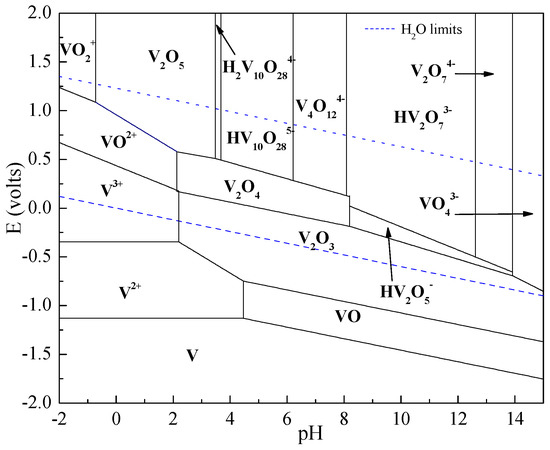
Figure 1.
E-pH diagram of the system V-H2O at 298.15 K (activity of vanadium is 1.0).
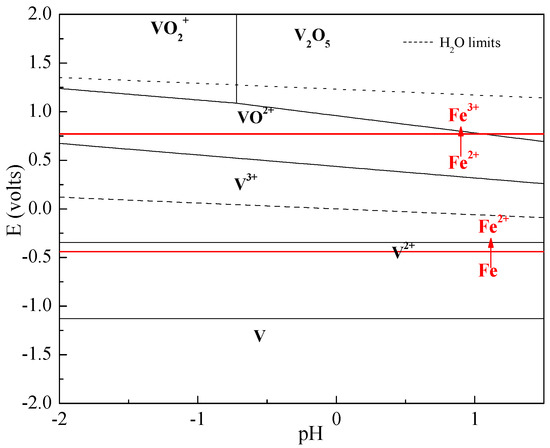
Figure 2.
E-pH diagram of the V-H2O and Fe-H2O systems at 298.15 K and low pH (Activities: Vanadium 1.0, iron 1.0).
The pH value of the solution directly affects the nature of the chemical species of the vanadium in the solution. Table 1 lists the chemical reactions and ΔrGθ in the V(IV)-S-H2O system at 278.15 K. After calculating, the reaction equilibrium constants and the relationship between the pH and logV(IV) of the different species, were obtained. Using these data, the activity-pH diagrams for V(IV)-water-sulfur systems was plotted (Figure 3). As can be seen from these data, the activity of V(IV), in solution, would be the lowest when the pH of the solution was around 5.0. Therefore, VO(OH)2 can be obtained through hydrolysis, by adjusting the pH of the strip liquor.

Table 1.
Chemical reactions and ΔrGθ in the V(IV)-S-H2O system at 278.15 K (ΔrGθ data were obtained from the literature [35]).
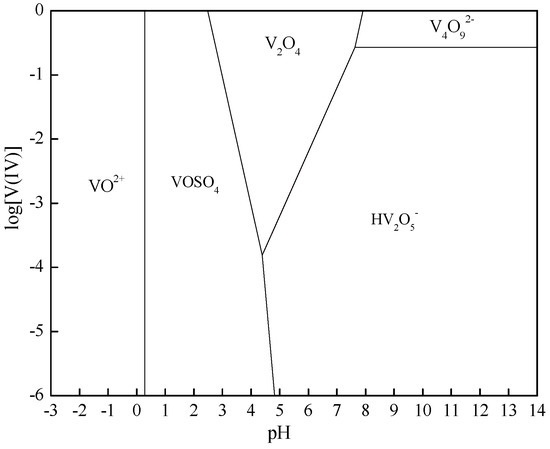
Figure 3.
Activity-pH diagram for V(IV)-S-H2O system at 298.15 K (activity of sulfur 1.0).
3. Materials and Methods
3.1. Materials and Analysis
The strip V(IV) liquor was obtained from a demo plant test, which was part of a project concerned with the extraction of vanadium from a decarburized vanadium-bearing shale. The vanadium-bearing shale containing 0.65 wt.% V2O5, 6.51 wt.% Al2O3, and 2.57 wt.% Fe2O3 was supplied by Datang Huayin Electric Power Co., Ltd. (Changsha, China). The H2SO4 and NaOH used in the study were of analytical grade, and all aqueous solutions were prepared using distilled water. The air and Argon gas used in this work were 99.9% pure and were supplied by Changsha Zhanyuan Gas Co., Ltd. (Changsha, China).
Vanadium was titrated with ammonium ferrous sulphate. The contents of other elements were measured by inductively-coupled plasma emission spectroscopy (ICP) with a PS-6 PLASMA SPECTROVAC, BAIRD (Waltham, MA, USA). Thermal gravimetric analysis (TGA), (Pyris 1 TGA, Perkin Elmer, Waltham, MA, USA) was used to identify the chemical reactions that occurred in the samples during the calcination processes. The products were characterized by X-ray diffraction (XRPD, PANalytical X’PERT-PRO diffractometer, Malvern Panalytical, Eindhoven, The Netherland).
3.2. Procedures
3.2.1. Source of the V(IV) Strip Liquor
The process flowchart for preparing the strip V(IV) liquor from the vanadium-bearing shale is shown in Figure 4. As shown, the sulfuric acid roasting, after water leaching, achieved a high leaching efficiency of vanadium. This technology and the detailed parameters of the process have been reported by our group [36]. The main composition of the acid leach solution is listed in Table 2, where it can be seen that it was a typical acid vanadium leach solution, with impurities like iron and aluminum. After removing the Al using alum, iron powder was used as the reductant to reduce the iron in solution from Fe(III) to Fe(II), avoiding the interference of Fe(III) in the V(IV) extraction. This principle was detailed in the previous thermodynamic analysis. After this initial treatment, Na2CO3 is added to the mixture to adjust the pH of the leach solution to about 2.5. Four stages of solvent extraction was then conducted, under the following conditions—the kerosene solution with 20% (v/v) D2EHPA and 5% (v/v) TBP, A/O phase ratio of 1:1, and an equilibrium time of 5 min. At last, the loaded organic phase was stripped by 1.0 mol/L H2SO4, with four stages, at an O/A phase ratio of 5:1 and equilibrium time of 5 min. The extraction and stripping process can be expressed by Equations (1) and (2):
Extraction: VO2+(aq) + 2(HA)2(o) ⇋ VOA2·2HA(o) + 2H+(aq)
Stripping: VOA2·2HA(o) + 2H+(aq) ⇋ VO2+(aq) + 2(HA)2(o)
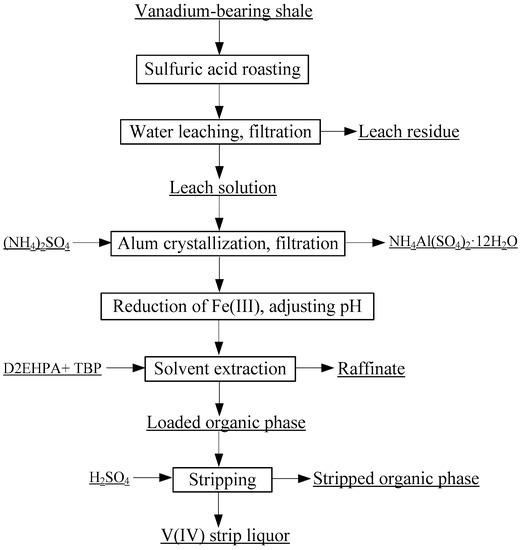
Figure 4.
Proposed flowchart for preparation of the V(IV) strip liquor from vanadium-bearing shale.

Table 2.
Chemical composition of the acid leach solution and the V(IV) strip liquor.
A blue band of V(IV) liquor, with a pH of about 0, containing 22.1 g/L vanadium was obtained. This band of V(IV) liquor was the raw material used to prepare the vanadium oxides and its composition is shown in Table 2. The results in Table 2 show that impurities had been removed in the process of enriching the vanadium, during the solvent extraction process.
3.2.2. Preparation of VO2 and V2O5
Figure 5 shows the proposed flowchart for the preparation of vanadium oxides from the V(IV) strip liquor. Before calcination, the VO(OH)2 precursor was prepared. Hydrolysis precipitation was used to precipitate the vanadium from the strip liquor. The precipitation percentage was affected by the final pH value and the temperature. Another issue that arose in this process was the control of the impurities in the hydrolysis products. There were few impurity ions in the strip liquor (Table 2), but the few Fe(III) could co-precipitate with VO(OH)2. It was due to the oxidation of Fe(II) by air and then the co-extraction with V(IV). Fortunately, the vanadium oxide products can have a small amount of iron, if they are applied in the steel industry. On the other hand, the hydrolysis product contained some inclusion of Na+, as NaOH was the neutralizer. Na+ should be eliminated by washing the precipitate. After obtaining a relatively pure VO(OH)2, a tube furnace (OTL 1200, Nanjing Nanda Instrument Co., Ltd. Nanjing, China) was used to calcine the vanadium hydroxide. The maximum working temperature of the tube furnace was 1100 °C and the maximum heating rate was 10 °C/min. The Schematic drawing of the experimental apparatus is shown in Figure 6. The reactions for the overall process can be expressed as follows:

Figure 5.
Proposed flowchart for preparation of vanadium oxides from the V(IV) strip liquor.
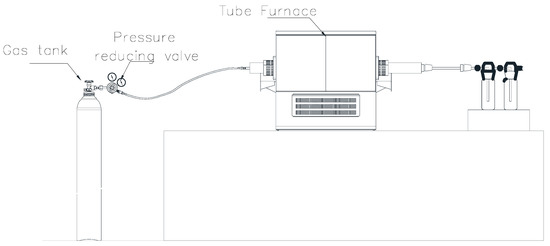
Figure 6.
Schematic drawing of experimental apparatus.
4. Results and Discussion
4.1. Effect of pH on Vanadium Precipitation
As shown in Figure 3, The V(IV) in the strip liquor can be hydrolyzed and precipitated by neutralization. The effect of the final solution pH on the V(IV) precipitation was determined by varying the pH of the solution from 4.2 to 10.7 and the results are shown in Figure 7.

Figure 7.
Effect of final pH on the vanadium precipitation percentage.
These experiments were conducted at room temperature for 30 min. As can be seen, the V(IV) precipitation yield increased with an increase in pH from 4.2 to 5.6, and it attained 99.5% at a pH of 5.6, then decreased. This effect was consistent with the data depicted in the activity-pH diagram for the V(IV)-water-sulfur system. The V(IV) was initially precipitated as VO(OH)2, but this would dissolve slowly when the pH was increased further, converting the VO(OH)2 to HV2O5−. Therefore, the optimum solution pH for V(IV) precipitation was around 5.6.
4.2. Effect of Time on Vanadium Precipitation
The effect of precipitation time on the V(IV) precipitation was evaluated at room temperature, after adjusting the pH to the optimum value of 5.6. Some samples were taken at various times, during the reaction, and the vanadium content of the solution after precipitation was determined. As shown in Figure 8, the precipitation of the V(IV) product was quite rapid. The precipitation yield reached 98.6% in 5 min, and no further increase was noted, with a prolonged reaction time. Therefore, 5 min of reaction was considered to be sufficient for the full precipitation of the desired product, after adjusting the solution pH to ~5.6.
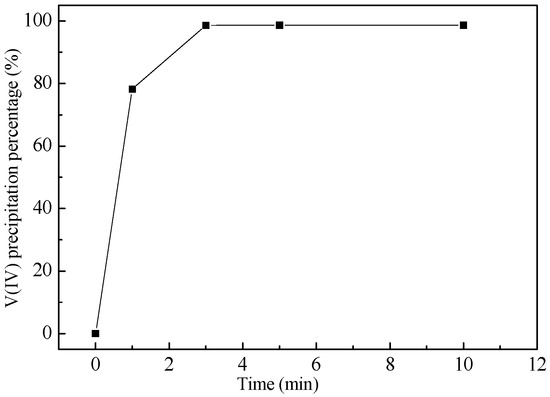
Figure 8.
Effect of reaction time on the concentration of vanadium precipitate.
4.3. Effect of Temperature on Vanadium Precipitation
The effect of temperature on the vanadium precipitation is shown in Figure 9. As can been seen from these results, the V(IV) precipitation yield was comparable at temperatures below 40 °C, but higher temperatures resulted in a decrease of the precipitation yield. This effect could be due to the re-dissolution of the precipitation at these higher temperatures. Therefore, it was concluded that room temperature was the optimum temperature for this process.
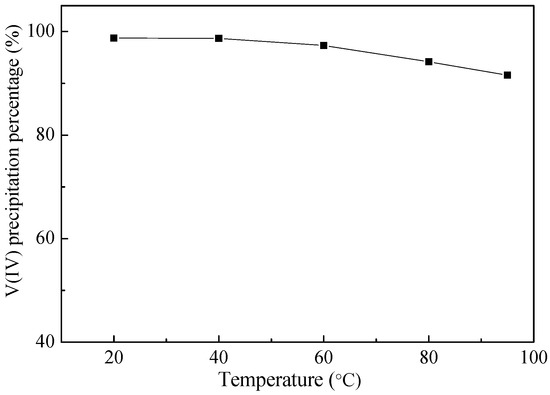
Figure 9.
Effect of temperature on the vanadium precipitation percentage.
4.4. Removal of Na+ by Washing
The resulting precipitate always contained some Na+, which needed to be removed before the calcining process could be conducted. It was found that washing the precipitate, with acidic water (pH ~2.0 with H2SO4), was effective in removing the unwanted Na+, and this washing needed to be conducted with stirring. Figure 10 shows the effect of washing on the liquid/solid ratio of the precipitate.
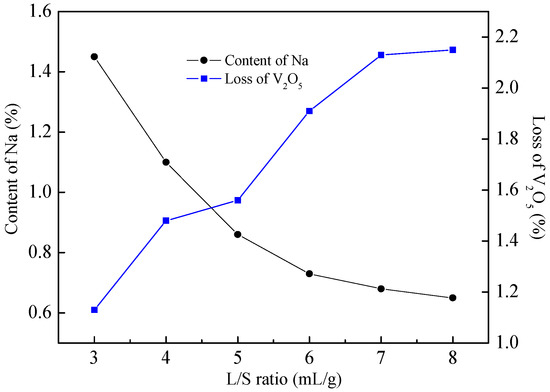
Figure 10.
Effect of liquid to solid ratio on the washing of Na+.
As can be seen from the results in Figure 10, the Na+ content in the VO(OH)2 decreased with the increase in the liquid/solid ratio, but the loss of vanadium increased, correspondingly. To meet the composition requirements of the products, an acidic water/precipitate weight ratio of 6/1 (mL/g) was used to wash out the Na+, and then a relative pure precursor, VO(OH)2 was obtained.
4.5. Preparation of VO2 and V2O5 by Calcination
Thermal (TG-DTA) analysis was utilized to study the behavior of VO(OH)2, during calcination in inert (argon) atmosphere and oxygen (air) atmosphere. Figure 11 shows the TG-DTA curves of the precursor in argon atmosphere.
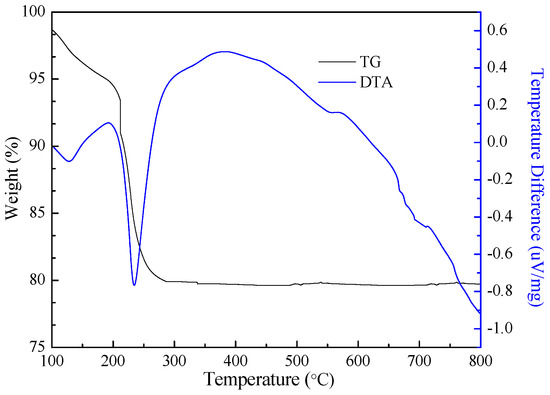
Figure 11.
Thermal (TG-DTA) analysis of the VO(OH)2 in argon atmosphere.
These results show that there was a small weight loss below 200 °C that was due to the loss of physically-adsorbed water, on the precipitate. A large weight loss occurred from 215 °C to 325 °C, which was accompanied by an evident endothermic peak (DTA), centered at about 238 °C. This result was attributed to the decomposition of the VO(OH)2. No additional weight change and endothermic peaks could be observed in the thermogram, after the temperature was greater than 325 °C. We can infer from these results that VO2 was produced and it gradually crystallized. As a comparative result, Figure 12 shows the thermal (TG-DTA) curves of the VO(OH)2 calcined in an air atmosphere. Below 270 °C, the precipitate behaved similarly to the precipitate calcined in argon. The decomposition of the VO(OH)2 also produced an endothermic peak (DTA) centered at about 238 °C, accompanied by a fast weight loss in the sample (TG). However, a small weight increase occurred from 275 °C to 410 °C, which was accompanied by a small exothermic peak (DTA). This was attributed to the oxidizing reaction, where the product transformed from VO2 to V2O5. In addition, the DTA curve, in air, resulted in an obvious endothermic peak, centered at about 690 °C. This was considered to be attributable to the melting point of V2O5 being 690 °C.
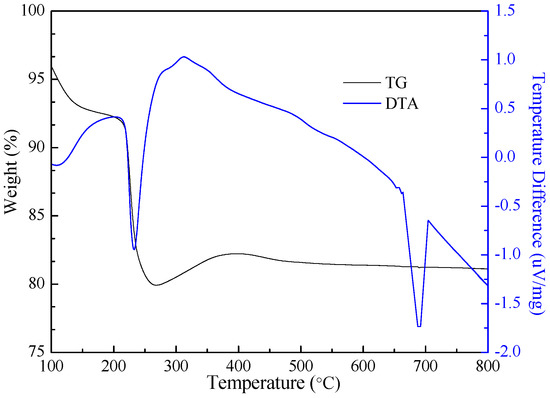
Figure 12.
Thermal (TG-DTA) analysis of the VO(OH)2 in air atmosphere.
Based on the results of the thermal (TG-DTA) analysis, the VO(OH)2 calcined in the tube furnace in argon and air atmosphere resulted in VO2, in air, and V2O5, in Ar. In the case of the VO2, the calcining was conducted with a temperature heating rate of 10 °C/min and an argon flow rate 50 mL/min. The VO2 powder product was obtained after 2 h of calcination at 550 °C. In the same manner, the V2O5 powder was produced, using the same conditions, with argon substituted for air. The two products were then characterized by XRD and the results are shown in Figure 13 and Figure 14.
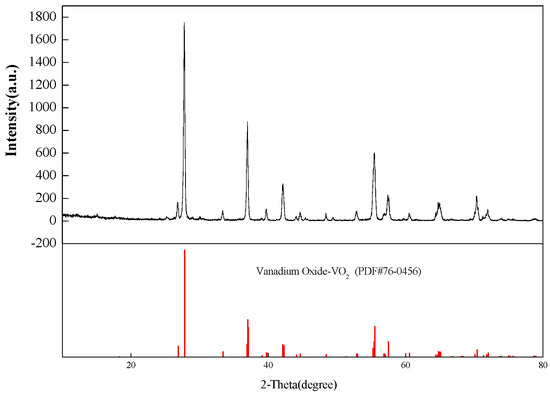
Figure 13.
XRD patterns of the product obtained after calcination in argon.

Figure 14.
XRD patterns of the product obtained after calcination in air.
By comparing the XRD patterns of the experimental products with the standard patterns for VO2 and V2O5, it was found that the XRD patterns of the products were identical to those of the pure VO2 and V2O5. This verified that the desired products had been successfully prepared by calcining the VO(OH)2 in argon and air. The compositions of the products (Table 3) were evaluated using ICP analysis, after dissolving the material in a suitable solvent. The results indicated that relatively pure products had been prepared using the proposed process flowchart.

Table 3.
Chemical composition of VO2 and V2O5 products.
5. Conclusions
In this reported study, a new method for the preparation of VO2 and V2O5 from a typical V(IV) strip liquor, which avoids using ammonium salts, was investigated. Thermodynamic analysis of the resulting experimental products showed that a vanadium precursor, VO(OH)2 could be obtained from the liquor, over a suitable pH range. It was found that adjusting the pH of the liquor to ~5.6, at room temperature, caused the vanadium precipitation yield to quickly reach its maximum. After obtaining the VO(OH)2 product, washing it with dilute acid ensured a low impurity-content. VO2 and V2O5 were then prepared from the VO(OH)2, using a tube furnace, with sequential atmospheres of air and argon. Characterization of products confirmed their structure and purity, which demonstrated the feasibility and performance of this process. According to the product standards [37], the products prepared by this method are suitable for applications in metallurgy, like steel additive. Further purification is necessary for a high-purity product. Nevertheless, compared to the traditional precipitation method, this proposed eco-friendly method employs simple equipment, together with a low reagent and energy consumption. Therefore, it is a feasible process for promoting cleaner production of vanadium oxide, in the vanadium chemical industry.
Author Contributions
Y.M performed the experiments and wrote the paper; X.W, M.W. and S.S. contributed the reagents/materials/analysis tools; Y.M., D.K., H.W. and B.F. analyzed the data.
Funding
This research received no external funding.
Acknowledgments
One of the authors (Y.M.) is grateful to the Chinese Government for providing a scholarship.
Conflicts of Interest
The authors declare no conflict of interest.
References
- Perles, T. Vanadium Market Fundamentals and Implications. In Proceedings of the Metal Bulletin 28th International Ferroalloys Conference, Berlin, Germany, 13 November 2012. [Google Scholar]
- Skyllaskazacos, M.; Cao, L.Y.; Kazacos, M.; Kausar, N.; Mousa, A. Vanadium electrolyte studies for the vanadium redox battery—A review. Cheminform 2016, 47, 1521–1543. [Google Scholar] [CrossRef]
- Zheng, Q.; Zhang, Y.; Huang, J.; Liu, T.; Xue, N.; Shi, Q. Optimal location of vanadium in muscovite and its geometrical and electronic properties by DFT calculation. Minerals 2017, 7, 32. [Google Scholar] [CrossRef]
- Kear, G.; Shah, A.; Walsh, F. Development of the all-vanadium redox flow battery for energy storage: A review of technological, financial and policy aspects. Int. J. Energy Research 2012, 36, 1105–1120. [Google Scholar] [CrossRef]
- Yang, X.; Zhang, Y.; Bao, S. Preparation high purity V2O5 from a typical low-grade refractory stone coal using a pyro-hydrometallurgical process. Minerals 2016, 6, 69. [Google Scholar] [CrossRef]
- Zhang, Y.; Bao, S.; Liu, T.; Chen, T.; Huang, J. The technology of extracting vanadium from stone coal in China: History, current status and future prospects. Hydrometallurgy 2011, 109, 116–124. [Google Scholar] [CrossRef]
- Moskalyk, R.R.; Alfantazi, A.M. Processing of vanadium: A review. Miner. Eng. 2003, 16, 793–805. [Google Scholar] [CrossRef]
- Raja, B. Vanadium market in the world. Steelworld 2007, 13, 19–22. [Google Scholar]
- Wu, Y.; Zhang, G.; Chou, K. Preparation of high quality ferrovanadium nitride by carbothermal reduction nitridation process. J. Min. Metall. B Metall. 2017, 53, 383–390. [Google Scholar] [CrossRef]
- Sikong, L.; Kumbour, P. A new route for thermochromic vanadium dioxide synthesis. Digest J. Nanomaterials Biostructures 2015, 10, 135–140. [Google Scholar]
- Osmolovskaya, O.; Murin, I.; Smirnov, V.; Osmolovsky, M. Synthesis of vanadium dioxide thin films and nanopowders a brief review. Rev. Adv. Mater. Sci. 2014, 36, 70–74. [Google Scholar]
- Lu, Y.; Zhou, X. Synthesis and characterization of nanorod-structured vanadium oxides. Thin Solid Films 2018, 660, 180–185. [Google Scholar] [CrossRef]
- Abbasi, M.H.; Safarnoorallah, M. extraction of vanadium oxide from boiler fuel ash. J. Adv. Mater. Eng. 2014, 17, 165–175. [Google Scholar]
- Chen, F.; Zhang, Y.; Huang, J.; Liu, T.; Xue, N. Mechanism of enhancing extraction of vanadium from stone coal by roasting with MgO. Minerals 2017, 7, 33. [Google Scholar] [CrossRef]
- Li, X.; Xie, B. Extraction of vanadium from high calcium vanadium slag using direct roasting and soda leaching. Int. J. Miner. Metall. Mater. 2012, 19, 595–601. [Google Scholar] [CrossRef]
- Dash, H.; Rout, D.; Kar, B. Extraction of vanadium from vanadium bearing spent catalyst through heat treatment method. Int. J. Innovative Res. Sci. Eng. Technol. 2013, 2, 3201–3203. [Google Scholar]
- Jena, B.; Dresler, W.; Reilly, I. Extraction of titanium, vanadium and iron from titanomagnetite deposits at pipestone lake, Manitoba, Canada. Miner. Eng. 1995, 8, 159–168. [Google Scholar] [CrossRef]
- Deng, Z.; Wei, C.; Fan, G.; Li, M.; Li, C.; Li, X. Extracting vanadium from stone-coal by oxygen pressure acid leaching and solvent extraction. Trans. Non-Ferrous Metall. Soc. China 2010, 20, s118–s122. [Google Scholar] [CrossRef]
- Ning, P.; Lin, X.; Wang, X.; Cao, H. High-efficient extraction of vanadium and its application in the utilization of the chromium-bearing vanadium slag. Chem. Eng. J. 2016, 301, 132–138. [Google Scholar] [CrossRef]
- Wang, Y.; Li, D.; Zhang, H. Main factors affecting precipitation of vanadium with acidic ammonium salt and its countermeasures. Iron Alloy 2012, 4, 12–16. (In Chinese) [Google Scholar]
- Wu, X.; Ming, X. Experimental study of V2O3 production with V2O5 as raw material. Rare Met. Ceme. Carbides 2015, 43, 15–17. [Google Scholar]
- Xu, C.; Pang, M. Preparation of VO2 powder by deoxidizing V2O5. J. Mater. Sci. Eng. 2006, 24, 252–254. [Google Scholar]
- Surmacz-Górska, J.; Cichon, A.; Miksch, K. Nitrogen removal from wastewater with high ammonia nitrogen concentration via shorter nitrification and denitrification. Water Sci. Tech. 1997, 36, 73–78. [Google Scholar] [CrossRef]
- Lin, L.; Yuan, S.; Chen, J.; Xu, Z.; Lu, X. Removal of ammonia nitrogen in wastewater by microwave radiation. J. Hazard. Mater. 2009, 161, 1063–1068. [Google Scholar] [CrossRef] [PubMed]
- Li, H.; Feng, Y.; Zou, X.; Luo, X. Study on microbial reduction of vanadium metallurgical waste water. Hydrometallurgy 2009, 99, 13–17. [Google Scholar] [CrossRef]
- Huang, W.; Zhang, Y.; Bao, S. Vacuum membrane distillation treatment of high concentration ammonia wastewater produced in vanadium extraction from stone coal. Min. Metall. Eng. 2012, 32, 103–106. [Google Scholar]
- Liu, B.; Zheng, S.; Wang, S.; Zhang, Y.; Du, H. The electrowinning of vanadium oxide from alkaline solution. Hydrometallurgy 2016, 165, 244–250. [Google Scholar] [CrossRef]
- Zhang, G.; Zhang, Y.; Bao, S.; Huang, J.; Zhang, L. A novel eco-friendly vanadium precipitation method by hydrothermal hydrogen reduction technology. Minerals 2017, 7, 182. [Google Scholar] [CrossRef]
- Wang, M.; Huang, S.; Chen, B.; Wang, X. A review of processing technologies for vanadium extraction from stone coal. Trans. Inst. Min. Metall. 2018. [Google Scholar] [CrossRef]
- Liu, Y.; Yang, C.; Li, P.; Li, S. A new process of extracting vanadium from stone coal. Int. J. Miner. Metall. Mater. 2010, 17, 381–388. [Google Scholar] [CrossRef]
- Li, X.; Wei, C.; Deng, Z.; Li, M.; Li, C.; Fan, G. Selective solvent extraction of vanadium over iron from a stone coal/black shale acid leach solution by D2EHPA/TBP. Hydrometallurgy 2011, 105, 359–363. [Google Scholar] [CrossRef]
- Yang, X.; Zhang, Y.; Bao, S.; Shen, C. Separation and recovery of vanadium from a sulfuric-acid leaching solution of stone coal by solvent extraction using trialkylamine. Sep. Purif. Technol. 2016, 164, 49–55. [Google Scholar] [CrossRef]
- Ma, Y.; Wang, X.; Wang, M.; Jiang, C.; Xiang, X.; Zhang, X. Separation of V(IV) and Fe(III) from the acid leach solution of stone coal by D2EHPA/TBP. Hydrometallurgy 2015, 153, 38–45. [Google Scholar] [CrossRef]
- Zhou, X.; Wei, C.; Li, M.; Qiu, S.; Li, X. Thermodynamics of vanadium-sulfur-water systems at 298 K. Hydrometallurgy 2011, 106, 104–112. [Google Scholar] [CrossRef]
- Dean, J. Langes’s Handbook of Chemistry, 13th ed.; McGraw-Hill, Inc.: New York, NY, USA, 1985. [Google Scholar]
- Wang, M.; Wang, X.; Li, B. A Novel Technology of Vanadium Extraction from Stone Coal. In Rare Metal Technology 2015; John Wiley & Sons, Inc.: Hoboken, NJ, USA, 2015; pp. 187–192. [Google Scholar]
- National Standard of People’s Republic of China, Vanadium pentoxide; YB/T 5304-2011; Standards Press of China: Beijing, China, 2005. (In Chinese)
© 2018 by the authors. Licensee MDPI, Basel, Switzerland. This article is an open access article distributed under the terms and conditions of the Creative Commons Attribution (CC BY) license (http://creativecommons.org/licenses/by/4.0/).